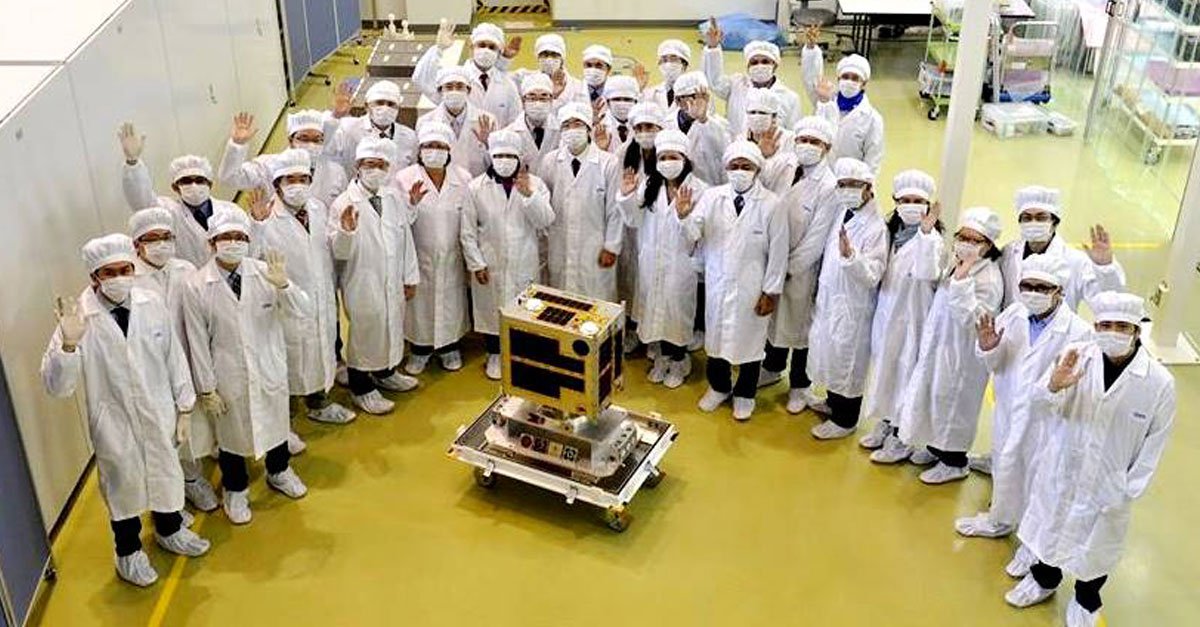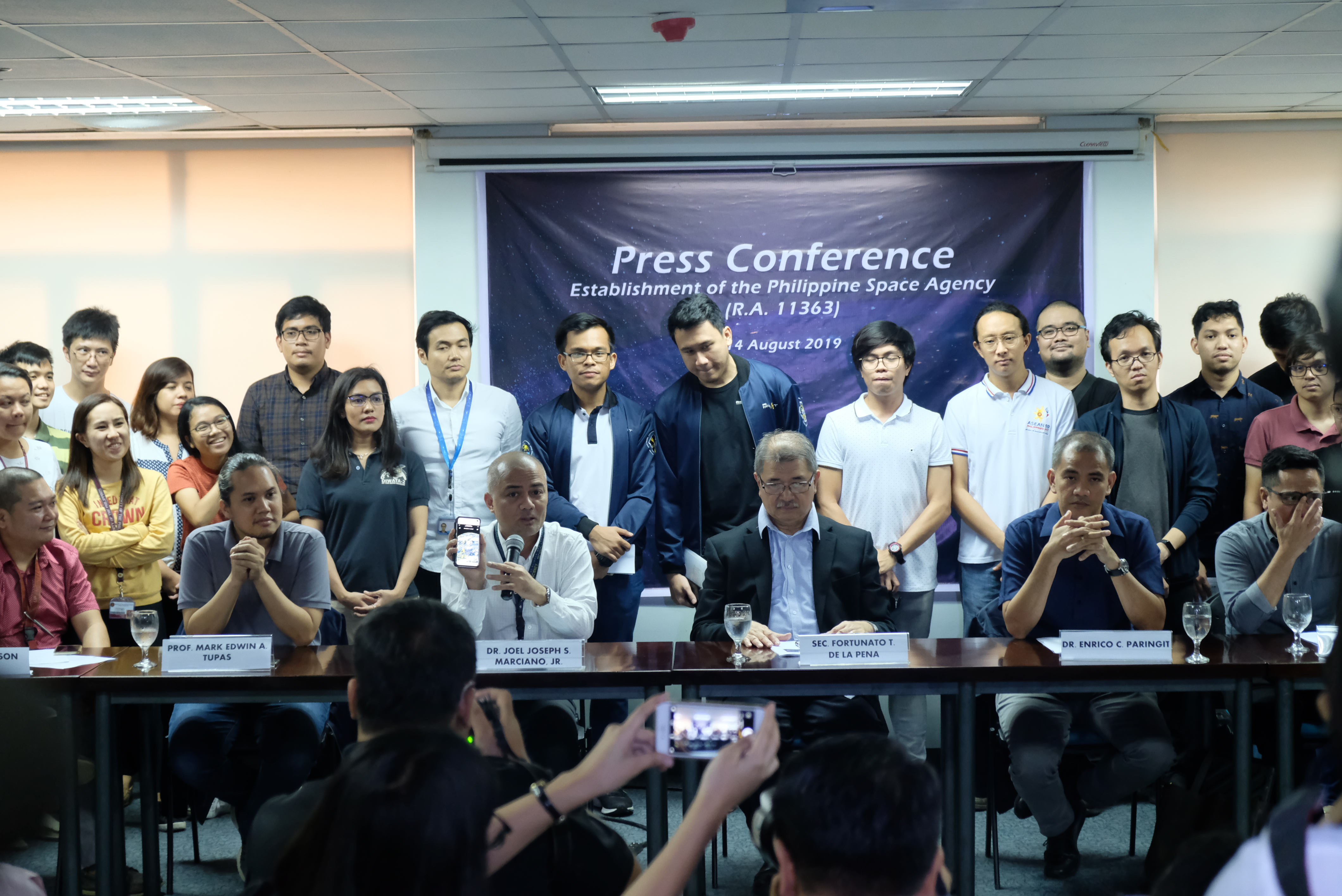|
STAMINA4Space
The Space Technology and Applications Mastery, Innovation and Advancement (abbreviated and stylized as STAMINA4Space) is a space technology program by the Philippine government. It is considered as the successor program to the Philippine Scientific Earth Observation Microsatellite (PHL-Microsat) program, a cooperation between the Philippine government and Japanese universities to develop microsatellites. The program is funded under the Department of Science and Technology. It aims to use the results from the PHL-Microsat program to further research and develop small satellite technology capability in the country. STAMINA4Space Program officially succeeded the PHL-Microsat program in August 2018, inheriting two satellites, Diwata-1 and Diwata-2 and the CubeSat Maya-1. Sub-projects The project is divided into five sub-projects. STEP-UP Project One of the four components of the STAMINA4Space Program is the Space Science and Technology Proliferation through University Partnershi ... [...More Info...] [...Related Items...] OR: [Wikipedia] [Google] [Baidu] |
Maya-1
Maya-1 was a Filipino nanosatellite. It was developed under the Philippine Scientific Earth Observation Microsatellite program (PHL-Microsat) and was jointly implemented by the University of the Philippines and the Department of Science and Technology as part of the Kyushu Institute of Technology-led multinational second Joint Global Multi-nations Birds Satellite (Birds-2). Maya-1 was the first nanosatellite of the Philippines. Background Following the launch of the Diwata-1 microsatellite in 2016, the Philippine Department of Science and Technology (DOST) announced on 29 June 2017 that two satellites, one nanosatellite and one microsatellite, will be launched in 2018. The government agency said that Filipino graduate students, Joven Javier and Adrian Salces attending Kyushu Institute of Technology (KIT), Japan were working on developing a satellite with their mentors which at that time was still to be named. The satellite, later dubbed as Maya-1, was developed mainly thr ... [...More Info...] [...Related Items...] OR: [Wikipedia] [Google] [Baidu] |
Philippine Scientific Earth Observation Microsatellite Program
The Philippine Scientific Earth Observation Microsatellite (PHL-Microsat) was a satellite program carried by the Department of Science and Technology (DOST) of the Philippines in cooperation with the Tohoku and Hokkaido Universities of Japan. Background Hokkaido University and Tohoku University of Japan initiated a project to send 50 microsatellites into space by 2050. The project will photograph aftermaths of natural disasters, partnering with governments, universities and other organizations based in Bangladesh, Indonesia, Malaysia, Myanmar, Mongolia, Philippines, Thailand, and Vietnam. Two satellites are commissioned for the Philippine government. Diwata-1 is the first satellite of the venture and is also a part of the Department of Science and Technology's Philippine Scientific Earth Observation Micro-Satellite (PHL-Microsat) Program which was initiated in December 2014 by the government agency. The satellite is an updated version of the Raijin-2, which was developed b ... [...More Info...] [...Related Items...] OR: [Wikipedia] [Google] [Baidu] |
Diwata-2
Diwata-2 or Diwata-2B is a Philippine microsatellite launched on October 29, 2018. It is the first satellite launched under the STAMINA4Space program. Development The satellite was developed by 11 scholars under the Philippine Department of Science and Technology (DOST), in cooperation with the Tohoku University and Hokkaido University in contrast to 9 DOST scholars who worked with Diwata-1, Diwata-2's predecessor. Unlike its predecessor, Diwata-2 takes advantage of radio communication technology by carrying an amateur radio payload for disaster relief purposes. The satellite also hosts all embedded features of its predecessor. The planning phase of the Diwata-2's development includes a simulation model, a mechanical test model, an engineering model and a flight model. This stage ended with the flight model which was completed on August 29, 2018, and was handed over to the Japan Aerospace Exploration Agency (JAXA) on the following day. Instruments Weighing , Diwata-2 hosts an a ... [...More Info...] [...Related Items...] OR: [Wikipedia] [Google] [Baidu] |
Department Of Science And Technology (Philippines)
The Department of Science and Technology (abbreviated as DOST; fil, Kagawaran ng Agham at Teknolohiya), is the Executive departments of the Philippines, executive department of the Philippine government responsible for the coordination of science and technology-related projects in the Philippines and to formulate policies and projects in the fields of science and technology in support of national development. History The DOST was formed as the National Science Development Board on June 13, 1958, during the administration of President Carlos P. Garcia. The science body was formed as a result of a law passed in the Congress of the Philippines, Congress upon the recommendation of Dr. Frank Co Tui, who was tasked by Garcia to conduct a survey regarding the state of science and technology in the country. It was reorganized as the National Science and Technology Authority (NSTA) on March 17, 1981, and was given broader policy-making and program implementing functions. On January 30, ... [...More Info...] [...Related Items...] OR: [Wikipedia] [Google] [Baidu] |
University Of The Philippines
The University of the Philippines (UP; fil, Pamantasan ng Pilipinas Unibersidad ng Pilipinas) is a state university system in the Philippines. It is the country's national university, as mandated by Republic Act No. 9500 (UP Charter of 2008), giving it institutional autonomy. Originally founded by the American colonial government on June 18, 1908, it was established through the ratification of Act No. 1870 of the 1st Philippine Legislature to serve as an "advanced instruction in literature, philosophy, the sciences and arts, and to give professional and technical training" to eligible students regardless of "age, sex, nationality, religious belief and political affiliation." The University of the Philippines system has 8 constituent universities (CUs): UP Diliman, which serves as the system's flagship university, UP Los Baños, UP Manila, UP Visayas, UP Open University, UP Mindanao, UP Baguio, and UP Cebu which are scattered across 17 campuses. Widely regarded an ... [...More Info...] [...Related Items...] OR: [Wikipedia] [Google] [Baidu] |
CubeSat
A CubeSat is a class of miniaturized satellite based around a form factor consisting of cubes. CubeSats have a mass of no more than per unit, and often use commercial off-the-shelf (COTS) components for their electronics and structure. CubeSats are put into orbit by deployers on the International Space Station, or launched as secondary payloads on a launch vehicle. , more than 1,600 CubeSats have been launched. In 1999, California Polytechnic State University (Cal Poly) professor Jordi Puig-Suari and Bob Twiggs, a professor at Stanford University Space Systems Development Laboratory, developed the CubeSat specifications to promote and develop the skills necessary for the design, manufacture, and testing of small satellites intended for low Earth orbit (LEO) that perform a number of scientific research functions and explore new space technologies. Academia accounted for the majority of CubeSat launches until 2013, when more than half of launches were for non-academic purpose ... [...More Info...] [...Related Items...] OR: [Wikipedia] [Google] [Baidu] |
Diwata-1
Diwata-1 also known as PHL-Microsat-1 was a Philippine microsatellite launched to the International Space Station (ISS) on March 23, 2016, and was deployed into orbit from the ISS on April 27, 2016. It was the first Philippine microsatellite and the first satellite built and designed by Filipinos. It was followed by Diwata-2, launched in 2018. Background Hokkaido University and Tohoku University of Japan initiated a project to send 50 microsatellites into space by 2050. The project will photograph aftermaths of natural disasters, partnering with governments, universities and other organizations based in Bangladesh, Indonesia, Malaysia, Myanmar, Mongolia, Philippines, Thailand, and Vietnam. Two satellites are commissioned for the Philippine government. Diwata-1 was the first satellite of the venture made possible through the Philippine Scientific Earth Observation Microsatellite (PHL-Microsat) Program, a three-year program funded by the Department of Science and Technology (DO ... [...More Info...] [...Related Items...] OR: [Wikipedia] [Google] [Baidu] |
Earth Imaging
Satellite images (also Earth observation imagery, spaceborne photography, or simply satellite photo) are images of Earth collected by imaging satellites operated by governments and businesses around the world. Satellite imaging companies sell images by licensing them to governments and businesses such as Apple Maps and Google Maps. History The first images from space were taken on sub-orbital flights. The U.S-launched V-2 flight on October 24, 1946, took one image every 1.5 seconds. With an apogee of 65 miles (105 km), these photos were from five times higher than the previous record, the 13.7 miles (22 km) by the Explorer II balloon mission in 1935. The first satellite (orbital) photographs of Earth were made on August 14, 1959, by the U.S. Explorer 6. The first satellite photographs of the Moon might have been made on October 6, 1959, by the Soviet satellite Luna 3, on a mission to photograph the far side of the Moon. The Blue Marble photograph was taken from sp ... [...More Info...] [...Related Items...] OR: [Wikipedia] [Google] [Baidu] |
Philippine Space Agency
The Philippine Space Agency (PhilSA) is the national space agency of the Philippines. The unified space agency is defined by the Philippine Space Act (Republic Act No. 11363) which was signed into law on August 8, 2019, by President Rodrigo Duterte, intended to manage and operate the decentralized space program of the Philippine government, which was handled by various agencies of the Department of Science and Technology (DOST). History Background Prior to the creation of the agency, the Philippine space program had two primary challenges: # insufficient funding; and # lack of a centralized agency to manage the space program. In the absence of a formal space agency, the DOST funded the National Space Development Program to set up the foundations of a future space agency. Several government agencies under the DOST had previously maintained the country's space program; namely the Philippine Atmospheric, Geophysical and Astronomical Services Administration (PAGASA), the Natio ... [...More Info...] [...Related Items...] OR: [Wikipedia] [Google] [Baidu] |
Kyushu Institute Of Technology
is one of the 87 national universities in Japan. Located in Fukuoka Prefecture on the island of Kyushu, it is dedicated to education and research in the fields of science and technology. It is earlier abbreviated to KIT and is now officially abbreviated to Kyutech. The founder was Matsumoto Kenjiro, second son of Yasukawa Keiichiro, and the links with the Yaskawa Electric Corporation (founded in 1915) remain strong to this day. The centenary of the opening of the Tobata campus is being celebrated in 2009, with Founder's Day on May 28, 2009. One of its famous alumnus is "Mr. Tornado", the severe storms researcher Tetsuya "Ted" Fujita. He graduated in 1943 and was an associate professor until 1953 when he was invited to the University of Chicago. History The university was granted government permission to be founded in 1907 as a private training school for engineers called ''Meiji Senmon Gakkō'' (Meiji Vocational School), toward the end of the Meiji period. The first campus ... [...More Info...] [...Related Items...] OR: [Wikipedia] [Google] [Baidu] |
International Space Station
The International Space Station (ISS) is the largest Modular design, modular space station currently in low Earth orbit. It is a multinational collaborative project involving five participating space agencies: NASA (United States), Roscosmos (Russia), JAXA (Japan), European Space Agency, ESA (Europe), and Canadian Space Agency, CSA (Canada). The ownership and use of the space station is established by intergovernmental treaties and agreements. The station serves as a microgravity and space environment research laboratory in which Scientific research on the International Space Station, scientific research is conducted in astrobiology, astronomy, meteorology, physics, and other fields. The ISS is suited for testing the spacecraft systems and equipment required for possible future long-duration missions to the Moon and Mars. The International Space Station programme, ISS programme evolved from the Space Station Freedom, Space Station ''Freedom'', a 1984 American proposal to constr ... [...More Info...] [...Related Items...] OR: [Wikipedia] [Google] [Baidu] |
.jpg)






